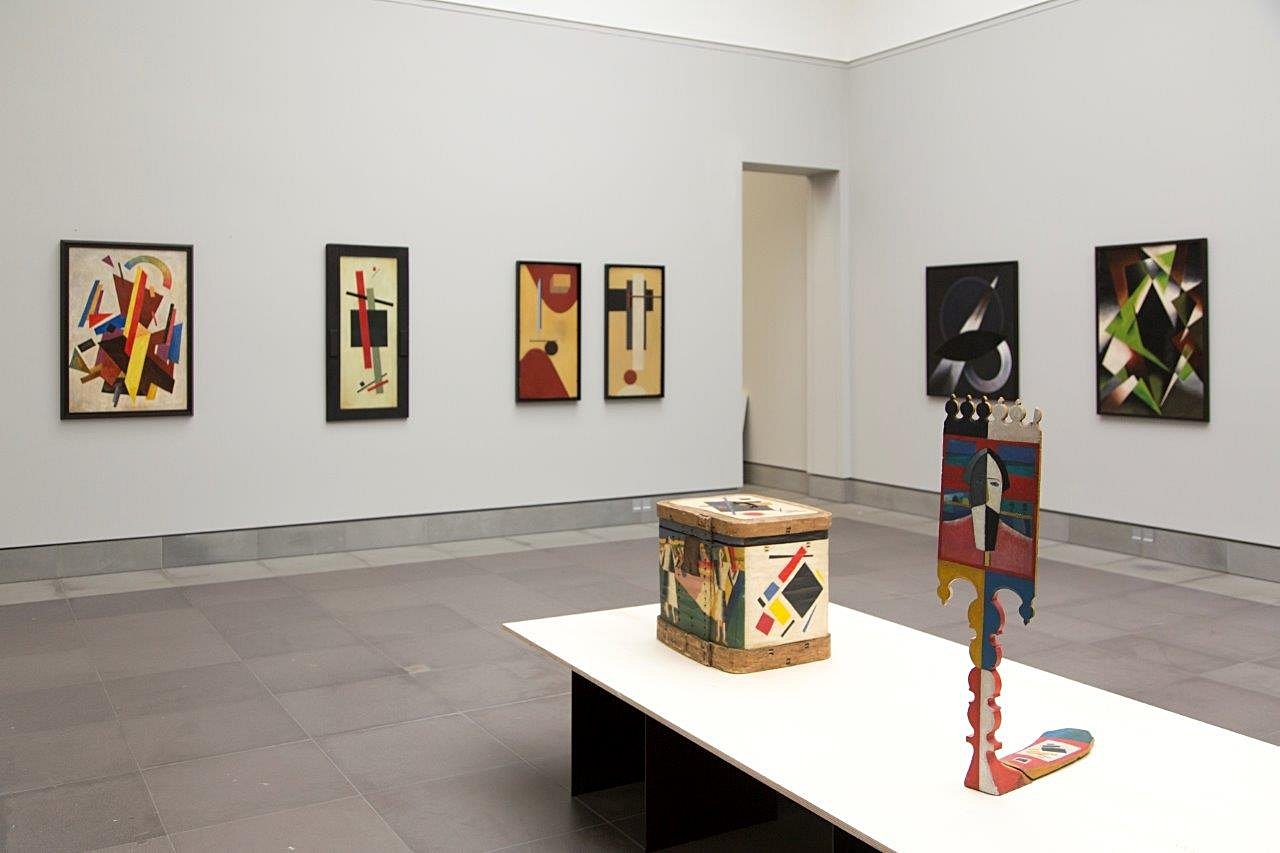
An exhibition of 26 never-before-seen Russian avant-garde works, purportedly made in the early 20th century by such radical artists as Wassily Kandinsky, Kazimir Malevich, Alexander Rodchenko, and Vladimir Tatlin, is coming under scrutiny this week. A number of prominent Russian art specialists are questioning the authorship of the works in an open letter to the Art Newspaper.
The paintings are on view in an exhibition called “Russian Modernism” at the Museum voor Schone Kunsten (MSK) in Ghent, Belgium. They are on loan from the Dieleghem Foundation, a registered charity owned by Brussels-based Russian businessman and art collector Igor Toporovski. The presentation, which opened at the end of October, is the prelude to a larger exhibition on the subject scheduled to debut at the museum at the end of 2018, according to the Belgian newspaper L’Echo.
The museum in Ghent says that the current presentation highlights “the creativity of the most important artists of the first half of the 20th century,” according to a press release for the exhibition. The display also includes work purportedly by Aleksandra Ekster, Natalia Goncharova, and Lyubov Popova.
L: Wassily Kandinsky’s Composition (1917) and detail of signature with second ‘N’ in Cyrillic ‘H.’ Photo: Colin Gleadell. Image courtesy of the Museum of Fine Arts, Ghent.
In the letter, due to be published online today, the specialists—many of whom are leading experts in the field—describe the works on view in Ghent as “highly questionable.” The signatories include art historian Aleksandra Shatskikh, who has written several books on Malevich; Natalia Murray of the Courtauld Institute of Art, who organized the exhibition “Revolution: Russian Art 1917–1932” at the Royal Academy last year; Vivian Endicott Barnett, the author of the catalogues raisonnés for Kandinsky and Alexej von Jawlensky; and Konstantin Akinsha, an arts journalist and curator.
Other signatories include dealers of modern Russian art James Butterwick (of London) and Ingrid Hutton (of New York); Julian Barran, the former director of Sotheby’s Impressionist and modern art department in London and former head of Sotheby’s France; Impressionist and modern art dealers Ivor Braka and Richard Nagy; and Alex Lachmann, the Russian art advisor and collector.
Although the word “fake” is not used in the letter, it is clear that the experts are suspicious that the works on display in Ghent could be inauthentic.
The paintings, they say, “have no exhibition history, have never before been reproduced in serious scholarly publications, and have no traceable sales records. The exhibited paintings by Wassily Kandinsky and Alexei von Jawlensky are not included in the catalogues raisonnés—internationally recognized as definitive sources for authentication of works of these artists. Objects such as a box and distaff allegedly decorated by Malevich [below, foreground] have no known analogues and there are no historical records that even mention that Malevich ever was involved in the decoration of such objects.”
Foreground: Objects including a box and distaff, allegedly decorated by Kazimir Malevich. Background, from left: paintings by Pavel Filonov, Yury Annenkov, Aleksandra Ekster, and Kazimir Malevich. Image courtesy of the Museum of Fine Arts, Ghent.
A spokesperson for MSK Ghent told artnet News that the museum followed standard procedures to review the loans ahead of the exhibition, speaking extensively with the collector and reviewing supporting material supplied by his foundation.
When asked to provide documentation of the works’ provenance, expert examination, or scientific analysis for proof of age, the museum deferred responsibility to the lender, Igor Toporovski.
“It is not the task of a museum to conduct chemical tests which are only done in cases of doubts before making acquisitions, not for loans,” the museum spokesperson said. “We have acted throughout, we believe, correctly in this matter, and in good faith.”
For his part, Toporovski asserted by email to artnet News: “In the international museum practice neither certificates of authenticity, nor chemical conclusions are required. Nevertheless, each art-work belonging to the Foundation has its own file: provenance, history and technical description (condition). The Foundation can provide this information on request, for research, scholars and professionals.”
Asked for more information, Toporovski invited this reporter to view the collection and materials in person, but said the details “could not be discussed by mail.” The collector and his wife Olga are also in the process of developing a permanent home for their holdings in Jette, Brussels, which is expected to open in 2020.
The letter to the Art Newspaper ends with a comment about the museum’s director, Catherine de Zegher. Although she is a noted expert in contemporary art and organized the Moscow Biennale in 2013, “this experience does not make her an expert on Russian avant-garde painting,” the signatories write. (A representative for the museum disputes this characterization, telling artnet News that de Zegher has written extensively on Malevich and other relevant artists.)
“When Ms. de Zegher became the director of the MSK she declared that her task was to create an ‘open museum,’” the letter concludes. “Unfortunately she opened the institution entrusted to her with questionable artworks.”